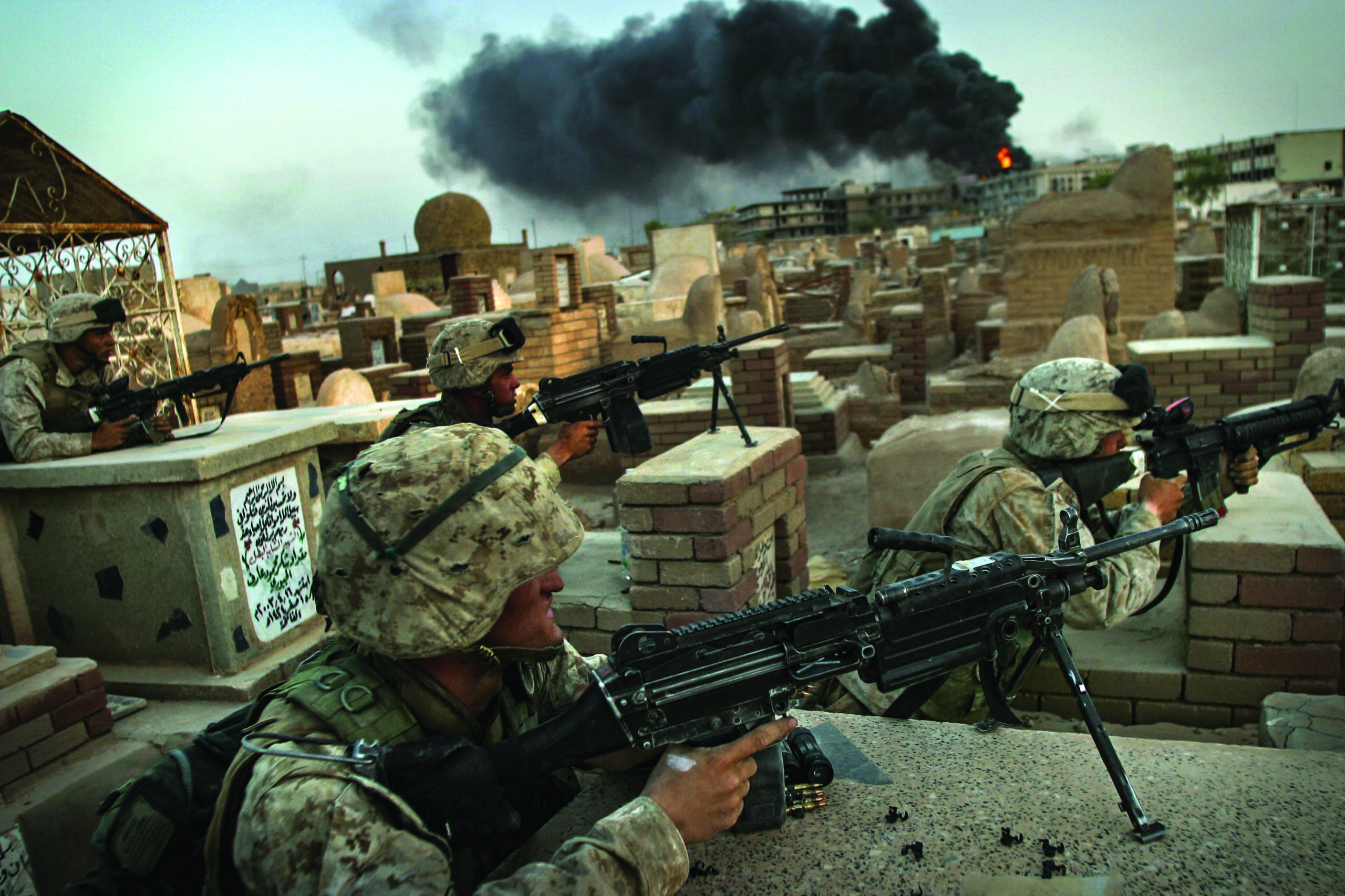
The Battle for Najaf, Part 1: Assaulting the “Valley of Peace”
By: Kyle WattsPosted on July 15, 2024
Author’s note: This month marks the 20th anniversary of the battle in Najaf, Iraq, fought by the warriors of Battalion Landing Team (BLT) 1st Battalion, 4th Marines, the 11th Marine Expeditionary Unit (MEU) and the U.S. Army’s 1-5 and 2-7 Cavalry. As more than a dozen Najaf veterans walked me through this epic struggle, I could not believe that I had never heard most of it before. The story of Najaf is largely overshadowed by the battle of Fallujah, coming just a few months later that tumultuous year and unfolding on a much larger scale.
For those who served in Najaf, even after 20 years the battle remains at the forefront of their minds. Today they are musicians, financial executives, FBI agents and congressmen. They are retired majors, colonels, master gunnery sergeants and chief warrant officers. An impressive number remain on active duty, looking back across decades of military service to a month in Iraq that many consider the capstone of their career.
“I think Najaf taught the Marine Corps a lot of lessons on urban warfare that we used in Fallujah,” one veteran reflected. “It was the pinnacle of what I did as a Marine.”
“It was the biggest fight I was ever part of,” stated another veteran of multiple deployments to Iraq and Afghanistan. “Nothing else ever came close.”
“There has never been another time in my career where the purpose, method, and end state of our mission was so well understood,” said one Marine still on active duty, a sergeant in 2004 and now a major. “That unit was the best infantry company I’ve ever served with.”
The lessons these veterans learned changed their outlook and impacted the way they molded junior Marines through the rest of their careers. Some were only 18 or 19 years old in Najaf and struggled later, feeling like nothing else they would do in the Marines could be more significant. Through city and cemetery, in tunnels and in the air, the Marines battled a numerically superior army of militia. The entire multi-national coalition force eventually dedicated assets from every branch of service in order to secure final victory. The details sounded like something out of a movie, or like many of the extraordinary combat stories told by Vietnam veterans. For the Marines who witnessed the carnage firsthand, I pray this story will shed light on your experience and personal sacrifices, and recognize your accomplishments for what they deserve. For the rest of us, I hope we can gain a glimpse of what it must have been like to be there and survive.
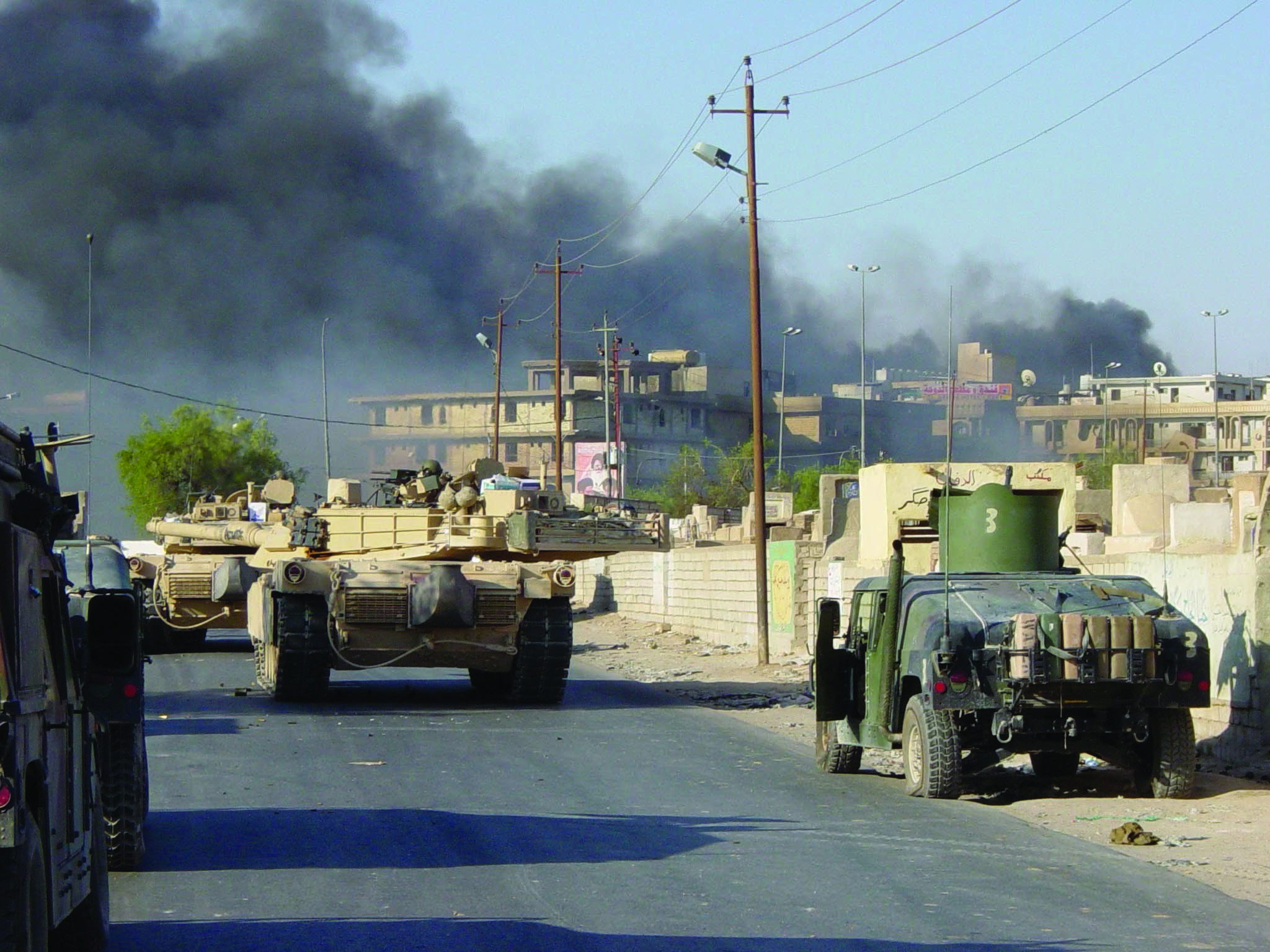
First Lieutenant Michael Borneo first experienced Najaf while riding with U.S. Army soldiers. As they prepared to depart the city, the outgoing soldiers drove the newly arrived Marines around the battlespace during their scheduled transfer of authority. The Army’s difference in mentality struck Borneo hard as he witnessed incongruous scenes. At some point, the soldiers settled into an agreement with the hostile militia based in Najaf. The Army controlled its sections of the city, and the militia controlled theirs. As Borneo toured the urban landscape, dozens of enemy fighters lined the streets and rooftops, openly brandishing their AK-47s and taunting the American convoy. He asked his driver if this was normal.
“That’s enemy territory,” the soldier replied. “That’s a ‘no-go’’ zone.”
Borneo pointed his rifle out the window and waved at each militiaman as they drove by.
“Marines are like children,” he said to the driver. “You tell us we can’t do something, that’s exactly what we’re going to do.”
At the Army’s Tactical Operations Center, Marines filtering through found a large map of Najaf highlighting the enemy-held sections in red. It looked like someone spilled a glass of Kool-Aid across large portions.
“I asked one of the soldiers why the map was all red, and he told me those were the ‘no-go’ zones,” remembered 1stLt Russell Thomas, the BLT’s tank platoon commander. “When I think ‘no-go’ zone, I’m thinking like a mountain that I can’t drive my tank over. I asked him what he meant, and he told me as long as they don’t go into those areas, the Mahdi Militia leave them alone.”
Someone cracked a smile and stated flatly that was not what the Marines came to do. Marines are hunters. They move toward the violence. The red areas showed them exactly where they needed to go. Once the Marines took over, the truce could not last long.
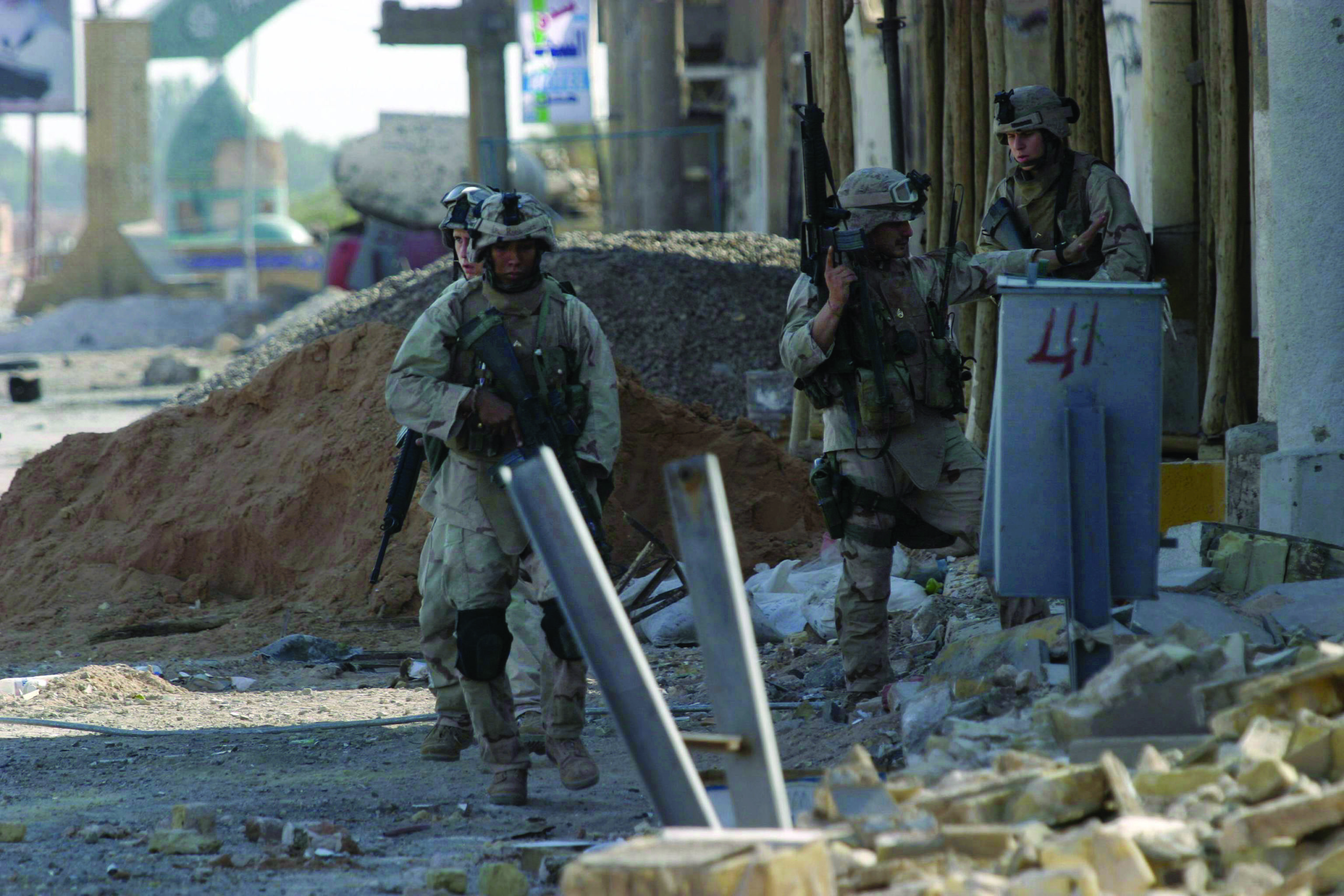
Marines from the 11th MEU arrived in Najaf in July 2004, less than two weeks into their deployment. They sailed across two oceans and drove 350 miles north from Kuwait to reach the city. BLT 1/4 operated as the MEU’s ground combat element. Nearly half the battalion deployed together during the invasion of Iraq the previous year. They returned home and immediately began working up for the summer 2004 deployment. For many of the young lieutenants and non-commissioned officers, Iraq was all they knew.
Like the rest of the war-torn country, Najaf plummeted into turmoil following the invasion and toppling of Saddam Hussein. The radical Shiite Muslim cleric Muqtada al-Sadr claimed Najaf as his hometown and established it as a base for his personal army, the Mahdi Militia. From this haven, situated 100 miles south of Baghdad, al-Sadr fomented revolt against the newly formed, American-backed government. His militia carried out assassinations and torture against government supporters and police, while reinforcing insurgents fighting in the capital and other cities around the country. A truce adopted by coalition forces in June 2004 brought a temporary lull in the nationwide fighting. Al-Sadr seized the opportunity to cement his control over Najaf and strengthen his militia for the next uprising.
“We knew something big was going to happen,” remembered John Mayer, then a lieutenant colonel and the command officer of BLT 1/4. “The whole thing was like a powder keg with sparks flying all around it. We just needed something to set it off.”
The MEU spread out across forward operating bases (FOBs) in the region. Colonel Anthony Haslam, the 11th MEU CO, concluded the relief in place with the Army on July 31. Less than 48 hours later, 1stLt Borneo set out with his Combined Anti-Armor Team (CAAT) to explore Najaf on the Marines’ first solo tour.
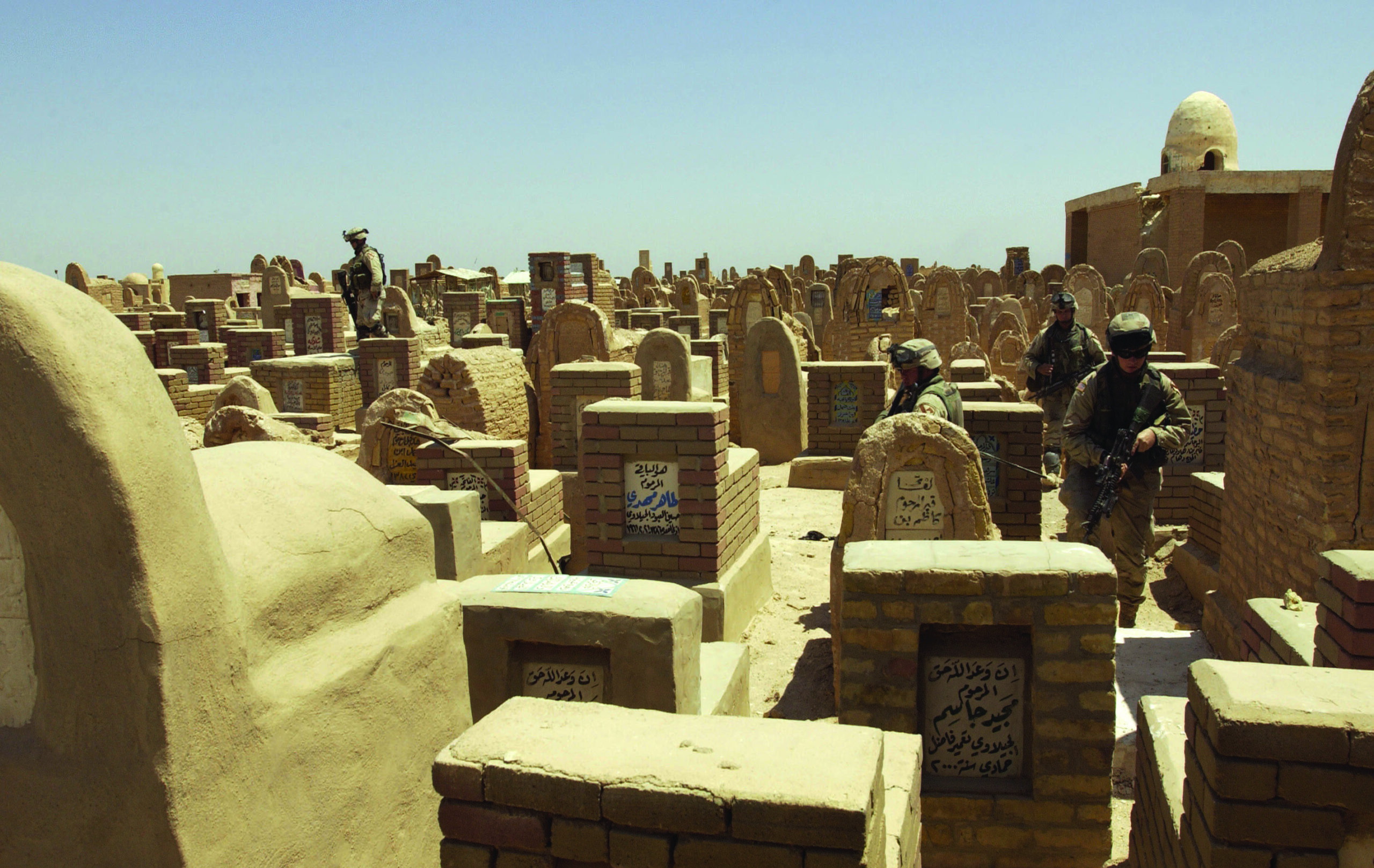
Borneo intended to probe the “enemy territory” within the city, but several exclusion zones remained off limits. Najaf held some of the most significant religious sites in Islam. The Wadi Al Salam cemetery, or “Valley of Peace,” is the largest cemetery in the world and dominated the northwestern quadrant of the city. It served as the final resting place of kings, sultans, and prophets, and has remained an active burial ground for 1,400 years. More importantly, the Imam Ali Shrine occupied the high ground within the “old city” of Najaf on the southern edge of the cemetery. The burial site of a cousin of the prophet Muhammad, the shrine ranked close behind Mecca on the list of Islamic holy sites, with millions of Muslim pilgrims visiting each year. Borneo’s patrol route scouted near these exclusion zones while inspecting 25 checkpoints along the way.
The CAAT platoon departed FOB Hotel, just outside the city, with eight HMMWVs and fewer than 40 Marines. They passed schools, police stations and other points of interest. The standard batches of armed militia greeted them. The Marines eventually approached a checkpoint listed as a maternity hospital complex. Unknown to them, the hospital sat adjacent to al-Sadr’s private residence and religious school. The CAAT platoon drove up to the front of the complex and stopped. Inside the walls, militia were everywhere.
“We kind of caught them with their pants down,” remembered Edward Roacho, then a private first class, now a first sergeant.
Standing behind the machine gun in his HMMWV turret, Roacho watched insurgents scramble inside the facility. They re-emerged armed with rifles, machine guns, rocket propelled grenades (RPGs), and mortar tubes, lining the walls and rooftops.
“It was like a Mexican standoff,” Roacho said. “They were looking at us and we were looking at them just wondering what was going to happen. My squad leader told me to point my machine gun down the street and mow down anything that tried to cross it.”
One of the Iraqi National Guardsman accompanying the patrol approached a group of militia and argued with them as they loaded a truck full of weaponry. A single AK-47 shot rang out from somewhere, and all hell broke loose.
A hail of small arms fire cracked through the air and impacted in the street. Borneo spread his vehicles out in a cordon around the complex. Their limited numbers notwithstanding, the CAAT platoon wielded a significant amount of firepower. The Marines opened up with the full complement of missile launchers, grenade launchers and machine guns mounted to their vehicles. Enemy mortar rounds impacted and machine guns barked in response. Borneo radioed FOB Hotel and requested the Quick Reaction Force (QRF) to come to their aid. His CAAT platoon was on its own for the next 30 minutes.
Roacho fired his .50-caliber as targets popped up everywhere. Enemy snipers fired on his vehicle from buildings inside the hospital complex. Roacho unloaded on the windows and upper floors, punching hundreds of holes through the thin concrete walls. An enemy fighter maneuvered to flank the HMMWV while Roacho suppressed the snipers. His squad leader killed the enemy with his M16 before moving through the open street to coerce the Iraqi National Guard soldiers into the fight.
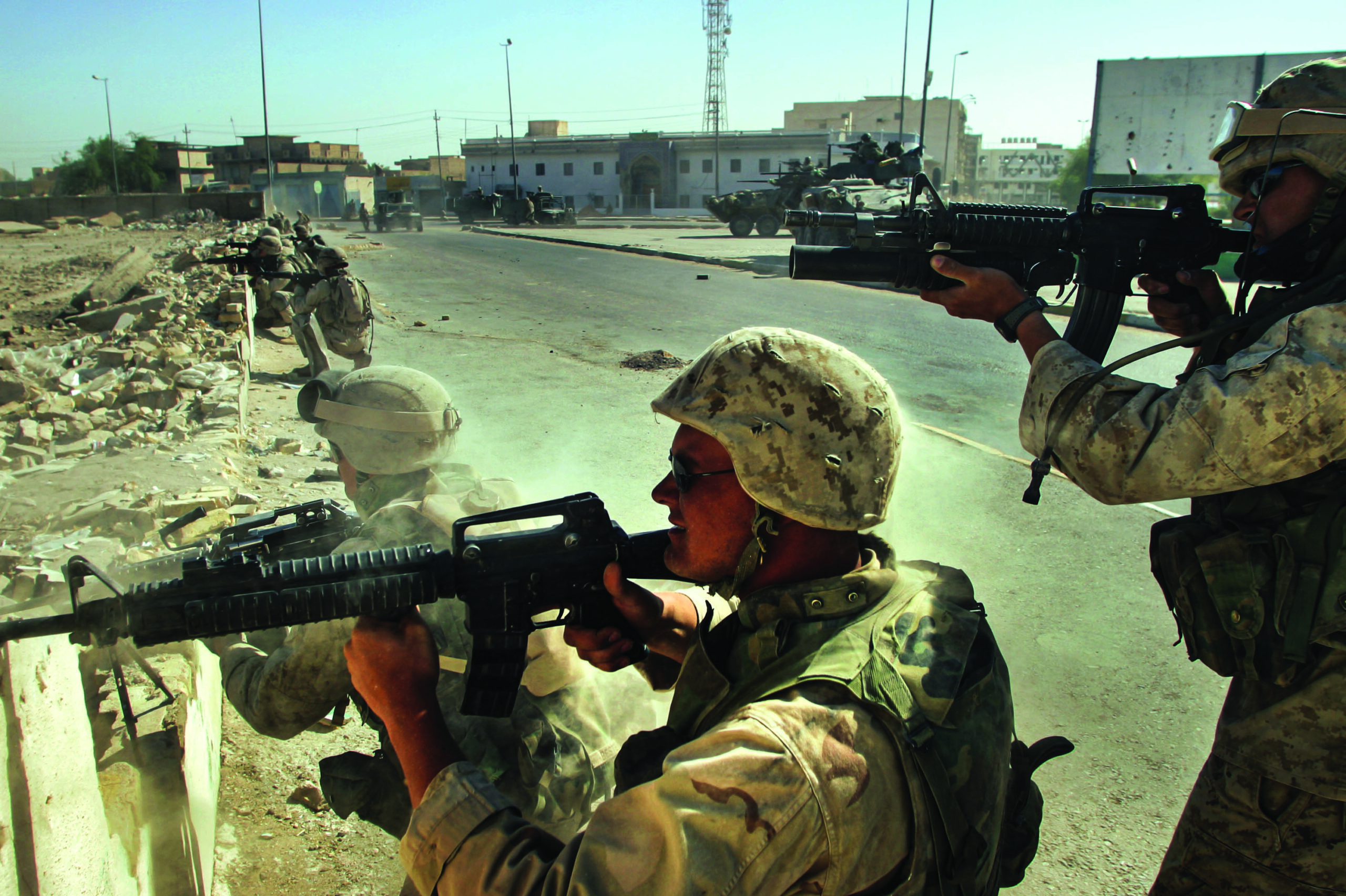
Enemy mortar teams fired from behind a wall and dirt berm, out of sight from direct fire weapons. Lance Corporal Eric Johnson climbed on top of a tractor trailer for an elevated point of view. He shot and killed two insurgents before drawing return fire. Bullets whizzed past and RPGs exploded nearby, but Johnson remained exposed on top of the trailer. Another Marine firing a MK-19 automatic grenade launcher arched rounds over the wall. Johnson spotted the impacts, walked the gunner onto the target, and eliminated the mortar position.
Lance Corporal Brandon Shaw stood in another HMMWV turret firing a MK-19 when he noticed two insurgents several hundred meters away. They hid in the shadows beneath a giant fuel tanker preparing to launch an RPG. Shaw adjusted his rounds onto their position. The tanker exploded in a tremendous ball of fire, incinerating the insurgents below.
The CAAT platoon ran low on ammo as the QRF finally arrived. Borneo used the billowing cloud of black smoke from the tanker to identify their position for incoming air support. After a furious hour of fighting, the patrol withdrew behind the supporting guns of the QRF and returned to FOB Hotel.
In the wake of the patrol, LtCol Mayer radioed each portion of his dispersed battalion and ordered them to Najaf. First Lieutenant Lamar Breshears commanded the 81mm Mortar Platoon from Weapons Company, stationed an hour east in Diwaniyah.
“Colonel Mayer called on the sat phone while that first patrol was still going on and told me to get my platoon and drive to Najaf,” said Breshears. “We were so new in country that I didn’t even have maps. I didn’t even know where Najaf was. He said, ‘just get on the main road, drive 45 minutes, and you’ll see a gunfight. Link up with Borneo.’ ”
The pause in fighting lasted just over 24 hours while both sides regrouped and massed their strength. The Mahdi Militia resumed the contest in the early morning hours of Aug. 5, assaulting the city’s main police station on the eastern boundary of the cemetery. After three successive attacks, each increasing in size and ferocity, Mayer again dispatched a QRF. Borneo’s CAAT platoon and Breshears’ mortar platoon joined forces with the BLT’s Light Armored Vehicle (LAV) platoon and part of “Charlie” Company to secure the police station and the surrounding area, called “Revolutionary Circle.”
Enemy fire poured onto the Marines as they arrived. Militia occupied every window and rooftop. Breshears’ platoon arrived at the battle, the first firefight of their deployment, in open-back HMMWVs. Militia fired straight down at them as the mortarmen leaped from their vehicles, shooting and moving toward a building for cover. As soon as they dismounted, a burst of machine-gun fire tore through a Marine’s groin and thigh. Others dragged him away to cover and began clearing the buildings room by room, floor by floor.
From the Wadi Al Salam cemetery, adjacent to Revolutionary Circle, enemy fighters moved about freely. A 5-foot wall lined the graveyard’s outer edge. Marines took cover beneath it, engaging targets, but unable to pursue. A forward air controller called for supporting fires into the cemetery to wipe out mortar and rocket positions. Each target in the exclusion zone required permission to engage, sometimes taking 30 minutes to approve. Huey and Cobra attack helicopters attached to Marine Medium Helicopter Squadron (HMM) 166 (Reinforced) arrived overhead and launched their attack runs.

Late in the morning, Captains Stephen Mount and Andrew Turner piloted their Huey over the cemetery. Mount controlled the chopper as it flew over 100 miles per hour just above building top level. Without warning, a wall of enemy small arms and machine-gun fire flew up in front of the Huey. Bullets tore through the metal skin and glass windshield. One round hit Mount’s face at the bridge of his nose, passed through his right eye, and exited his head near his temple. In the seat next to him, Turner felt the Huey suddenly lurch backward and point toward the sky. Mount’s head bobbled as blood poured down from inside his helmet. Turner clutched the controls. The helicopter spun toward the ground. At such a low altitude, recovery was hopeless. Turner somehow guided the careening chopper past a web of buildings and power lines before it bounced in the street and slid to a stop just outside the cemetery.
Marines along the wall watched in horror as the Huey spiraled out of sight. Some veterans served long enough to remember the Battle of Mogadishu in 1993. Even the youngest Marines had watched the film, “Black Hawk Down.” Visions of burnt out helicopters and mutilated American bodies being dragged through the streets flashed through their minds as the Huey crashed. Those nearest mounted up and sped toward the crash site. They refused to let this be their “Black Hawk Down” moment.
The four Huey crew members escaped with minor wounds, save Mount. Miraculously, he survived the headshot and crash, and remained conscious throughout the entire incident. Turner extricated himself from the cockpit as Staff Sergeant Patrick Burgess and Corporal Theodora Naranjo removed Mount. The crew formed a hasty defense in front of a nearby building. With rifle at the ready, Turner scanned the surrounding streets for incoming militia. He noticed a red crescent painted on the wall of the building next to him and two ambulances parked under a carport; a hospital. Still in full flight gear, helmet on and visor down, he ran inside with his M16 expecting to find enemy, hoping to find medical supplies. Mercifully, a friendly civilian doctor approached and went outside to care for Mount.
Borneo’s CAAT platoon arrived at the crash site within minutes. LAVs and other Marines arriving on scene secured a perimeter while the crew was evacuated. Enemy militia fought to reach the crash. A Cobra that flew alongside the downed Huey lit up the surrounding streets while Marines on the ground defended the crash site until the militia disappeared. Sporadic enemy fire continued as the Marines commandeered an Iraqi ambulance to evacuate Mount, Turner, and Naranjo. Burgess endured the crash, extricated Mount, and extinguished an engine fire, then still remained on scene to help dismantle the chopper and ensure nothing fell into enemy hands.

A recovery convoy formed to retrieve the Huey. As the vehicles neared the crash site, a militia soldier wildly sprayed them with his AK-47. Tragically, one round struck and killed Sgt Moses D. Rocha as he reloaded his machine gun in a HMMWV turret. The recovery team loaded the Huey under continued intermittent fire and transported the wreckage back to base.
Temperatures skyrocketed over 100 degrees as the battle raged through the day. Haslam and Mayer brought every heavy weapon available into the fight. Airstrikes into the cemetery continued. The BLT Artillery platoon, firing 155mm howitzers from FOB Hotel, shot dozens of rounds into the old city. The BLT’s platoon of four M1 Abrams tanks mobilized and pushed through the streets under heavy fire, engaging buildings with their coaxial machine guns and main guns. LAVs staged along the cemetery wall mowed down militia as they appeared. Lance Corporal Michael Novak manned the 25mm cannon of one LAV. Over a three-hour period, Novak singlehandedly killed nearly 20 enemy fighters as they attempted to cross the road into the cemetery. No matter how many militia the Marines killed, more materialized.
As the afternoon wore on, Mayer decided that in order to destroy the enemy resistance, he needed to assault their haven inside the cemetery. This option posed tremendous difficulty. For the average American, the idea of a large cemetery evokes images of a site like Arlington National Cemetery, with its perfectly spaced headstones and manicured rolling hills. The “Valley of Peace,” however, proved infinitely more vast, erratic and confounding.
The “Valley of Peace” spans over 2,200 acres, with more than 6 million Muslims interred. Arlington, by contrast, occupies 639 acres, with 400,000 graves. Anyone who has visited the graveyards of New Orleans, with their above-ground mausoleums, can begin to picture the cemetery in Najaf. A person’s stature or religious importance in life dictated the size of their mausoleum, with some two-story structures the size of a small house. Graves of all shapes and sizes literally stacked on top of each other with no apparent order, in an effort to be buried as close as possible to the Imam Ali Shrine on the cemetery’s southern border. The resulting maze of ancient stone and concrete produced a terrifying city within the city that could only be cleared by Marines on foot.
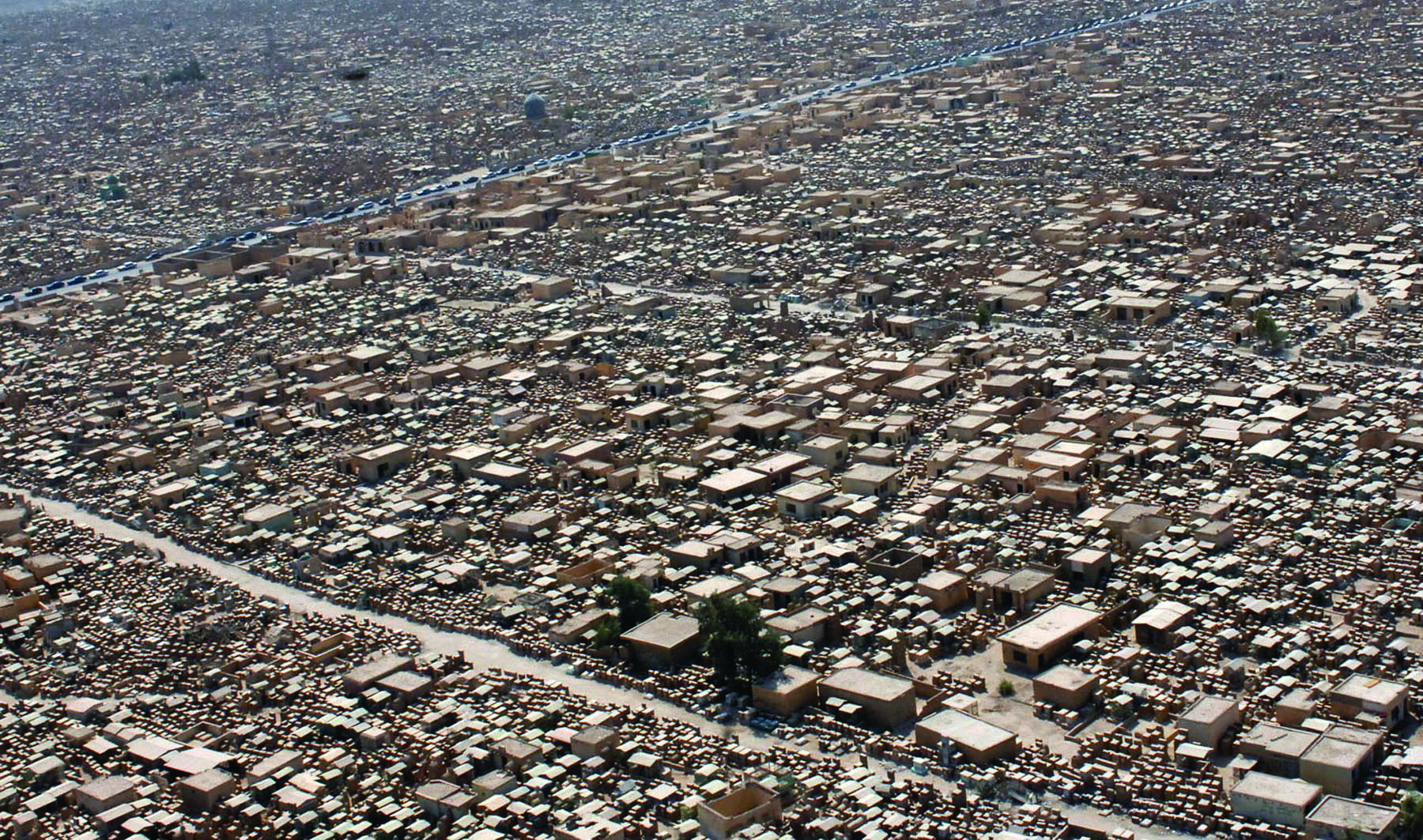
Mayer forwarded his request to enter the exclusion zone up the chain. The cemetery’s sensitive nature forced the decision as high as it could go, beyond the most senior commanders in Iraq to the Pentagon and White House.
Approval finally arrived. The assault kicked off at 6 p.m., just before dusk.
Marines from every company of BLT 1/4 pushed into the cemetery. They weaved through the mausoleums on high alert. Adjoining units lost sight of one another and struggled to remain in contact. Some paths dead ended into impenetrable rows of tombs, forcing Marines to work backwards and find a way around. At times, Marines climbed over the smaller structures. The brittle concrete collapsed under their weight and Marines fell through, joining the decomposed occupants in their graves. Sniper fire from buildings outside the cemetery evolved into small arms and machine guns as the Marines penetrated further. Militiamen popped out from behind mausoleums only meters away to fire a burst then disappear. Their voices and gunfire echoed around the tombs in a dizzying cacophony. Sweat soaked and exhausted, the Marines made eye contact with their prey, trading curses and gunfire as they dove deeper into the chaos.
The battle flared in every direction. Marines pushed through sections of tombs, only to have militia emerge behind them attacking from the cleared area. They discovered that many of the doors guarding mausoleum entrances concealed not just an above ground tomb, but staircases descending into a web of underground catacombs. Ghastly walls of skeleton feet hung out into tunnels connecting with some other unknown door above ground elsewhere in the cemetery. From then on, Marines depleted their supply of grenades, fragging every tunnel entrance they found.
Breshears’ mortar platoon, on foot in the cemetery as provisional infantry, engaged a 40-man enemy force at dusk in one of the fiercest battles of the day.
“We were on line and could hear them talking, but we couldn’t tell where they were,” he remembered. “We came over a little hill and there were guys like right there, several squad sized elements. We started trading fire at about 10 meters. We were close enough that one of my Marines caught a grenade and threw it back. There wasn’t any maneuvering, it was just like how fast can you pull the trigger. Even as a lieutenant, I went through nine magazines in my M16, in a space of maybe 20 minutes. They had defensive positions prepared with sandbags and interlocking fields of fire. Between them and us, almost 100 people all opened up right there at close range.”

Mayer ordered the assault force to halt their advance and fall back. Coordinating the fight in daylight proved difficult enough. Continuing after dark presented exceedingly greater risk. Breshears received the order to pull back in the wake of his pitched fight with the concentrated enemy force. His Marines served as the connecting link between Alpha Co and Charlie Co on either flank. The surrounding units fell back as Breshears relayed the order. The combat grew so loud that at one point, Breshears pulled out a note pad and wrote down the order for a Marine who could directly in his ear.
As his mortarmen pulled back, Breshears searched through the surrounding tombs for his last remaining section still heavily engaged with the enemy. Sergeant Yadir Reynoso directed his squad in their battle. Militia filled the void left on three sides of the squad after other units withdrew, not realizing his squad remained forward and exposed. An enemy machine-gunner pinned the Marines down with a steady rate of fire. Reynoso ordered his squad to withdraw while he remained in place. He repeatedly exposed himself from behind a tomb to suppress the enemy machine gun. In doing so, the rest of his squad successfully pulled back. Reynoso was finally shot from two directions at the same time, mortally wounding him.
Lance Corporal Justin Vaughn observed Reynoso fall. He didn’t hesitate as he turned back to recover his squad leader’s body. With total disregard for his own safety, Vaughn climbed on top of the mausoleum in front of him and leaped from tomb to tomb. Head to toe in full view of the enemy, he sprinted under fire across the tops of the graves until he reached Reynoso. He stripped some of Reynoso’s gear, then carried him 150 meters back. Astoundingly, Vaughn braved the journey a second time, retrieving all of Reynoso’s gear except his kevlar helmet, then collapsed from heat exhaustion.
With the Marines pulled back to the edge of the cemetery, Mayer brought out the biggest of his big guns. A U.S. Air Force AC-130 gunship arrived overhead under the cover of darkness. Only a handful of these vicious death dealers operated across the entire country. The aircraft’s arrival over Najaf on the night of Aug. 5 marked the first of nearly 20 continuous nights of dedicated support, highlighting the significance of the battle to the coalition effort in Iraq.
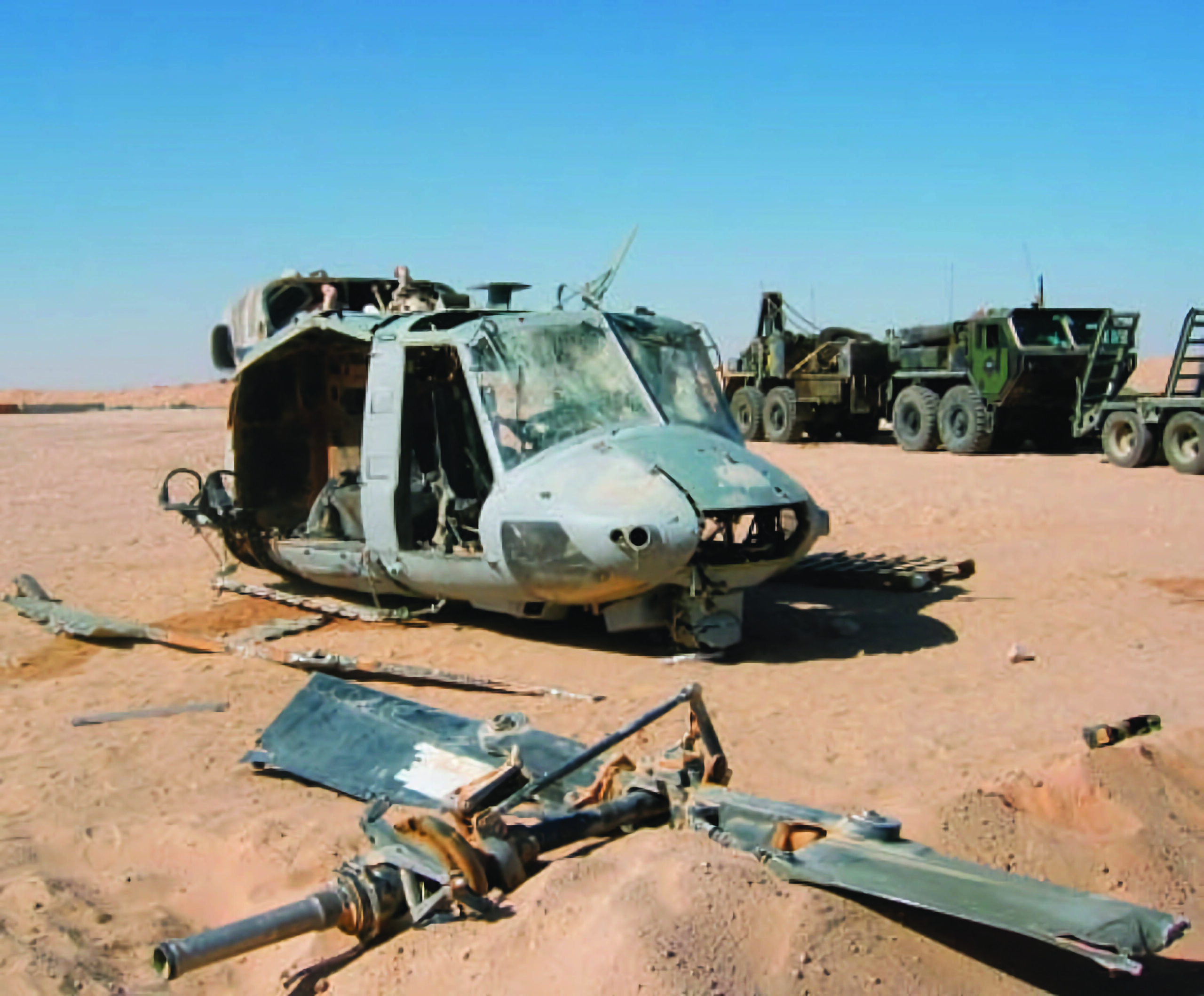
The menacing rumble of the airplane filtered down through the night sky to the Marines along the wall. Basher was her name, and she had a voice. Not just the voice of her many weapons raining death to the enemy below, but the calming voice of an angel. A female airman aboard the plane operated the radio, calling out enemy movement spotted through the aircraft’s superior optics. Any Marine lucky enough to be near a radio tuned in to listen as the forward air controllers (FACs) talked to her.
“25 targets moving northwest of your position, permission to engage?” she might say. Suddenly, the 105mm howitzer aboard the aircraft, or one of the other cannons or grenade launchers, would open up. Her calm voice inevitably followed. “25 targets eliminated.”
With each successful strike, the voice of Basher tallied the head count over the radio. The Marines stood by as the AC-130 remained on station through the night.
“On that first night, I bet you we killed hundreds of militia,” reflected Mayer, who held the responsibility of approving all AC-130 strikes in the cemetery. “We had never seen what an AC-130 could do, and neither had the enemy. It was incredible.”
Despite suffering heavy losses, the Mahdi militia resumed the battle at dawn on Aug. 6 with a barrage of mortars. They fired on the Marines from positions in the cemetery, as well as from within the walls of the Imam Ali Shrine. FACs brought air support in to deal with mortars in the cemetery, but the Shrine remained an untouchable exclusion zone where the militia could operate with impunity.
The four tanks from 1stLt Thomas’ tank platoon proved indispensable, and the only weapon in the Marines’ arsenal practically impervious to anything the enemy could throw at it. Throughout the previous day, the tankers engaged the enemy in the buildings lining the streets along the cemetery. The Marines buttoned up inside while rifle and machine-gun bullets ricocheted off their armor and mortar shrapnel rained down. On their initial push into the city, Thomas watched a mortar round detonate on top of the tank in front of him. The violence increased throughout the first day of the cemetery fight, climaxing the following morning as the tanks pushed down the main road along the south side of the cemetery heading towards the shrine.
“There was so much enemy fire and munitions exploding around us that I could barely see the tank in front of me,” Thomas recalled. “I don’t think anybody realized yet what we were getting into. I watched radio antennas and other pieces of gear get blown off our tanks, meanwhile, we’re sending main gun round after main gun round into all these buildings. A big wall followed the road, separating us from the cemetery and the Marines we were supporting. I couldn’t see them and I was just wondering how in the hell they were even surviving.”
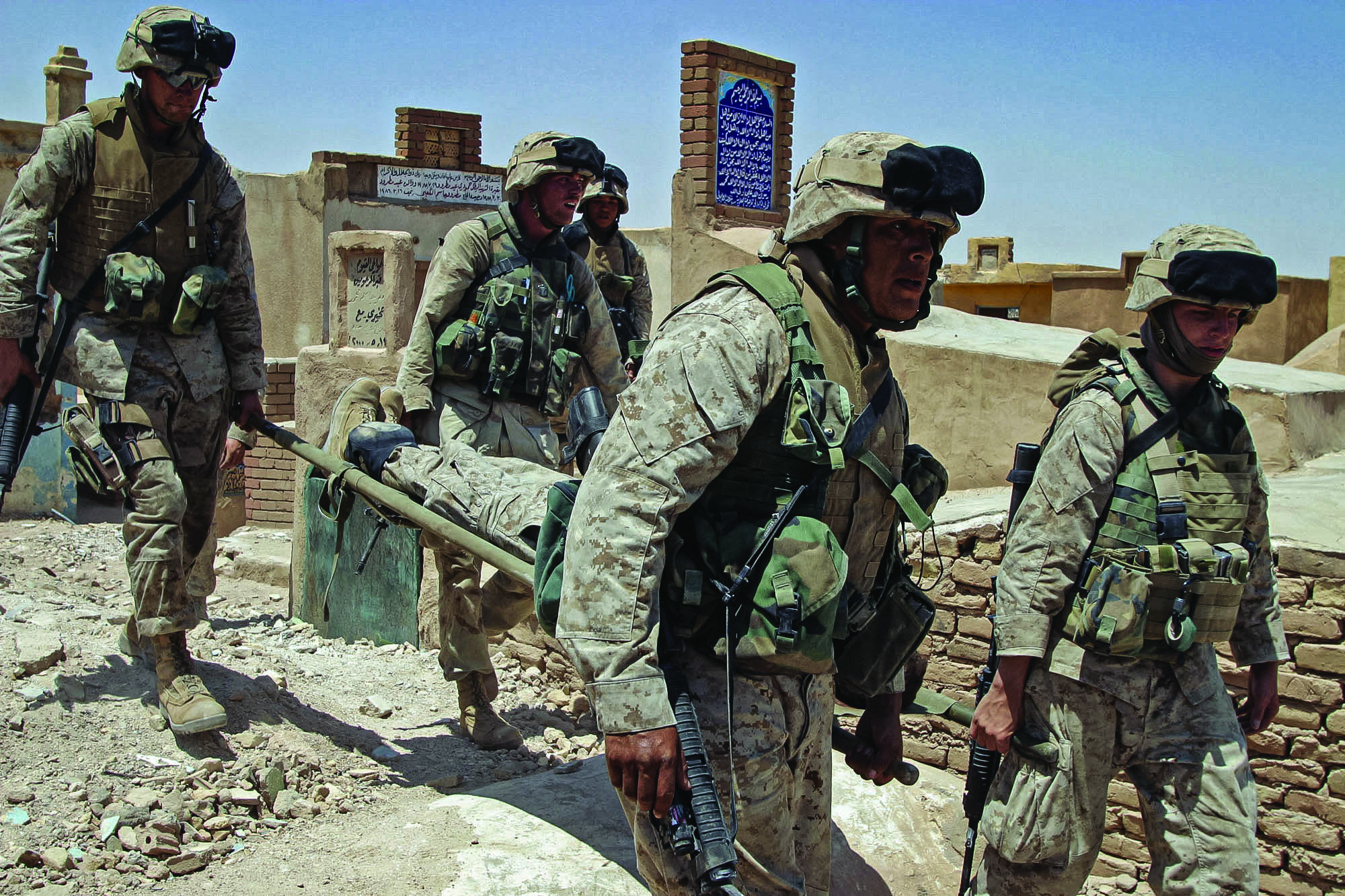
At one point during the day, a group of enemy continually harassed Marines from a hotel situated at a prominent corner overlooking the cemetery. The grunts took cover behind the tanks and communicated with the tankers through a telephone attached to the outside. They directed several main gun rounds at various locations in the building before finally identifying enemy fighters located on the roof. Gunnery Sergeant Michael Philley, the tank platoon sergeant, traversed his main gun as high as it could reach and fired.
The round exploded on an air conditioning unit, erupting a massive fireball high into the sky. Exhilarated Marines across the cemetery whooped and cursed at the motivating sight. Thomas feared the gigantic explosion might somehow mean the end of his career, but soon relaxed when the CO came over the radio; “Good shot!”
The tankers worked to the brink of their endurance. With outside air temperatures holding well over 100 degrees, the Marines baked inside their tanks. Fumes from the overworked vehicles caused them to vomit, further exacerbating their dehydration. Thomas devised a rotation, with two tanks remaining at the front, while the other two temporarily returned to the FOB to rest, rehydrate, and conduct emergency maintenance. The platoon corpsman worked aggressively to hydrate the exhausted Marines, starting IVs in each arm with multiple fluid bags dripping at the same time. They pushed beyond their limits to continue supporting the grunts. In some cases, Marines returned to the city with IV bags still hanging inside their tank. Though Thomas’ rotation cut the number of available tanks in half, it kept his platoon in the fight.
Marine casualties increased in proportion to militia casualties. Charlie Company suffered its first KIA on Aug. 6, when a sniper shot and killed LCpl Larry Wells as he moved between the tombs.
Late that afternoon, Breshears’ platoon came under mortar fire. The Marines identified the source and made visual contact with the insurgents operating the mortar. Breshears radioed for artillery to wipe them out, but the mission was denied due to the enemy’s close proximity to the shrine. Tragically, more mortar rounds detonated around the platoon, instantly killing Cpl Roberto Abad and wounding others. In less than 48 hours since his platoon arrived in Najaf, Breshears suffered two killed and nine wounded. The MEU lost nearly 70 wounded or killed in the cemetery.
Hospital Corpsman Third Class Matt Schmahl served as one of the few Navy “docs” attached to the 11th MEU dedicated to flying casualty evacuation missions. His role made him part of an exceedingly rare breed of corpsmen in the Fleet Marine Force to earn the Marine Corps designation as combat aircrew qualified. Schmahl operated out of a CH-46 helicopter. Unlike his counterparts in the army, flying in Blackhawks specifically designed and outfitted as air ambulances, Schmahl worked with nothing but his personally purchased medical bag.
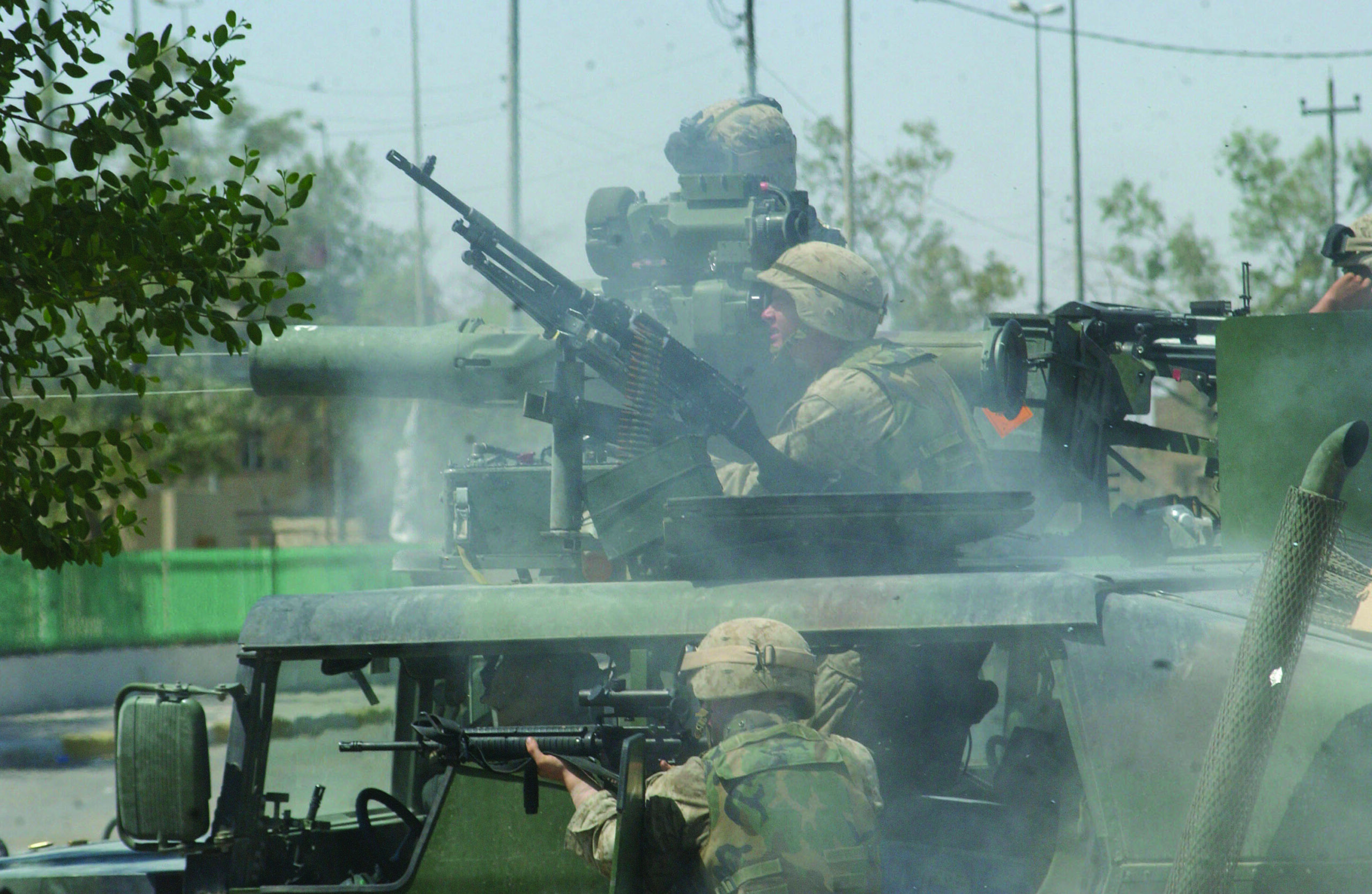
One of Schmahl’s first missions identified an “urgent surgical” patient, signifying the wounded Marine would likely die if he did not make it to a hospital within one hour. The trauma center in Baghdad lay roughly 40 minutes away, leaving medevac crews an extremely tight window.
The CH-46 dropped in near the cemetery over the grunts’ casualty collection point. As soon as they came within range, enemy machine-gun tracers arched through the sky. Mortar rounds impacted in the dirt, bracketing the Marine position. The pilot told Schmahl and the aircraft’s crew chief the landing zone was too hot to keep the bird on the ground. They would have to get off, package the patient, and let him know once they were ready for pick up. Schmahl heaved his medical bag on his back. The crew chief, a former infantryman, grabbed a shotgun. The aircraft touched down and the pair sprinted down the open tail ramp. Enemy machine guns kept the bird under fire. The crew chief shouted at Schmahl as they hauled ass toward the casualty collection point.
“Well, I guess I’m a grunt again!”
They made it to the Marine position where HMMWVs circled around the casualty and the grunt corpsman treating him. Schmahl found a young Marine with his entire lower jaw missing. The Marine was in shock, fighting for his life and fighting those who attempted to care for him. With nothing to do but get the patient to the trauma center, Schmahl requested the helicopter return immediately.
Tracers and RPGs targeted the helicopter again as it lifted off with the patient. Schmahl struggled with the combative Marine for the duration of the flight to Baghdad, keeping his airway secure and clear of blood. Finally, they reached the hospital. The Marine survived.
Schmahl evacuated multiple urgent surgical casualties and walking wounded from Breshears’ platoon following the mortar strike that killed Cpl Abad. Several flights evacuated “Angels” alongside the wounded; the medevac term for KIA.
Casualty evacuations soared following the assault into the cemetery. Every corpsman who volunteered to fly was soon overworked. Even the flight surgeon, a Naval officer and doctor, went forward to help on medevac missions.
“That would be like having your battalion commander on the front lines as a point man,” Schmahl reflected. “We quickly realized if this was going to be sustainable, we were going to need help.”
Haslam and Mayer arrived at the same conclusion. Despite the massive amount of firepower available to the Marines, they were sorely outnumbered. BLT 1/4 possessed roughly 800 Marines to combat the Mahdi Militia. This total included all attached assets, including tanks, artillery and support personnel. Estimates on enemy strength in Najaf ranged as high as 4,000 strong. Additionally, the militia brought an impressive arsenal to the fight, with various size mortars, an abundance of RPGs, recoilless rocket launchers, man-packed surface-to-air missiles, and several Russian-made twin or quad-barreled antiaircraft guns.
The Marines halted the advance and withdrew to the FOB on the morning of Aug. 7. They inflicted enemy casualties around the cemetery many times greater than their own. Haslam requested up the chain of command for reinforcements while the Marines rested, cleaned their weapons, and prepared to get back into the fight. Their battle with Muqtada al-Sadr and his Mahdi militia had only just begun.
Executive Editor’s note: “The Battle for Najaf, Part 2” will be published in the September issue of Leatherneck.
Author’s bio: Kyle Watts is the staff writer for Leatherneck. He served on active duty in the Marine Corps as a communications officer from 2009-2013. He is the 2019 winner of the Colonel Robert Debs Heinl Jr. Award for Marine Corps History. He lives in Richmond, Va., with his wife and three children.




